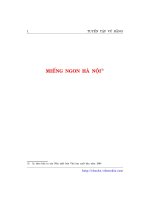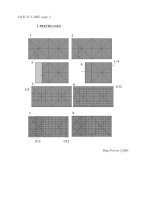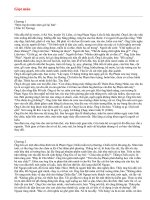Pet Portrait ppt
Bạn đang xem bản rút gọn của tài liệu. Xem và tải ngay bản đầy đủ của tài liệu tại đây (284.16 KB, 13 trang )
Pet Portrait
People keep asking me: "How do you do it?" Especially beginning artists are
often floundering, struggling with how and where to begin. Colored pencil
seems like an easy medium to use, but to achieve any kind of mastery, it can
become exceedingly difficult and unforgiving. There is only so much erasing
you can do before the board or paper no longer yields the pigments without
damage, and blending and layering can easily result in "mud."
So, here I am going to present the basic process I use, although it will vary
with each piece. Other artists work differently, but this is how my technique
evolved over the years.
The subject: while I am working from a photo, this is one of my dogs, so it
helps to have her sitting next to me as I work. In any project, a good
reference photo or two will go a long way toward a successful piece of art.
Image size: 12" x 16". This is a common size for pet portraits and one that
yields the desired results in a reasonable amount of time. I'll try to keep track
of that time, too.
Medium: Prismacolor Colored Pencils
Note: the images of each stage are large to show better detail (30-50k). If
you are on a slow connection, they will take a while to load. Colors are
close, but not true; I can spend only so much time on correcting the scans,
and we're talking about the overall process. I will list the colors I use in each
step.
Stage 1
I start with a light
pencil sketch on the
board, with as few
lines as possible.
Depending on my
reference photos, I
sometimes spend
considerable time
working out the
proportions on
paper, then
transferring the final
version to the board.
I use various types
of illustration board
or, as in this case,
colored matboard
(Crescent # 1024, a
bluish gray). Bristol
board is about the
lightest I work on.
In this image, I've
started to block in
the dog's outline in
two colors: Sepia
and Goldenrod. The
lower portion still
shows the graphite
pencil outline. I
erase the pencil
marks as I go along,
because the graphite
will dirty whatever
colors I lay over it.
Stage 2
The entire image is
now blocked in, and
I've added two more
colors to hint at the
highlights: White
and Cream. At this
stage, I get an
overall feel on how
the picture works. I
start to see the
personality and
expression of the
animal. If I am
dissatisfied, I might
start over at the
sketch stage,
adjusting the areas I
feel are weak. Not a
great loss, because I
haven't invested that
much time yet, in
this case about 1 ½
hours (could be
considerably more if
I am working from
poor photos).
Next, I will detail
the eyes and face,
my second "check
point."
Stage 3
The eyes and face
make or break the
portrait. At this
stage, I work slowly
and cautiously. This
is also where an
understanding of
anatomy (like the
flews and the lay of
the hair), from study
and observation,
particularly comes
in handy. Without it,
I would not be able
to extrapolate the
necessary detail
from some of the
poor photos I often
work from.
New colors: Dark
Brown, Dark
Umber, Burnt
Ochre, Sienna
Brown, Mineral
Orange, Black,
Jasmine, Cool Grey
90%, Cool Grey
10%, French Grey
90%, French Grey
50%, Cloud Blue,
Raw Umber, Yellow
Ochre, Light Peach
Time: About 2
hours
From here on, I
pretty much work
from the top down,
laying down more
and more color and
detail. The muzzle
needs more work, as
(The colors in this scan are closer to true than the
previous ones)
does most of the
face.
Stage 4
Stepping back. As
the portrait
progresses, I step
back often (about
three to four feet, or
more when I work
on larger pieces) to
view the entire
effect. It's easy to
get lost in the detail,
and stepping back
provides a way of
checking the work.
New colors: at this
stage I pretty much
work with what I've
used so far. I might
add different
percentage greys,
like French Grey
50%, but by now I
have a fair grip on
the palette for this
piece, which also
allows me to work
under artificial
"daylight",
particularly in the
short daylight hours
of winter. I did add
Bronze as I started
working the belly
area.
Time: couldn't keep
track of it, but
somewhere between
8-10 hours; it will
take at least another
two hours to reach
stage 5
Artistic Interpretation. The photos supplied by clients are often small,
unclear, and of the wrong color, which is why I ask for several.
Even when I
take my own, as in this case, the pose may be perfect, but the lighting less
than ideal, the exposure wrong, the wrong film, or any number of problems.
Knowing the subject as intimately as I do, I've adjusted for the photo's
shortcomings, as well as for faded colors in the dog's neck area (where a
distinct black band earned her her name). I can't always do that with
someone else's pet, but multiple photos, taken under a variety of
circumstances and lighting, as well as interviews with the client and/or
observing the pet at home (if possible) will usually yield a fairly accurate
image of the animal I am working on.
To show the relationship between painting and photo I'll add a proportional
side-by-side on the final page.
Stage 5
Finishing touches
and removal. At
the final stage, I go
over and refine
some of the details,
add shadows and
background hints to
anchor the image. I
will look at the
overall color
balance; in this case,
because I felt the
light areas were too
yellow and the mid-
tones too red, I
applied a light coat
of Grayed Lavender
to those troublesome
areas to mute their
intensity. As I have
done all along, I
continue to wipe
very gently the
colored pencil
Almost finished version (The colors in this scan are
closer to true than the previous ones, although the
background isn't quite as blue)
surface with soft
tissue to remove and
prevent any wax
buildup (bloom). I
usually wait several
days before spraying
with fixative to
distance myself in
order to detect and
correct possible
flaws.
In this case, I am not
happy with the chain
collar. After
spraying with
workable fixative, I
will refine that
particular area.
Spraying prevents
intrusion of adjacent
colors.
Additional tools used throughout: Berol Apsco Electric Sharpener;
sandpaper pad; eraser guard; plastic eraser; tissue; soft dust brush
Time: an additional hour or so. Total: about 15 hours
Part of the process is knowing. Knowing is the deeper understanding of an
animal. An at least basic knowledge of anatomy, be it based on observation
and/or study, helps in making interpretive choices. My animal science
studies weren't entirely wasted after all! Mammals share a lot of
characteristics across species, even down to the lay of the hair and swirls on
the face, in many instances; bone structures and muscling are similar. A
knowledgeable artist can apply that knowledge in order to develop a piece
from even the poorest photos.









